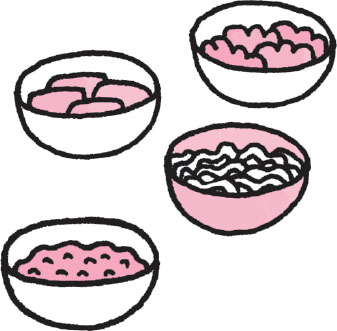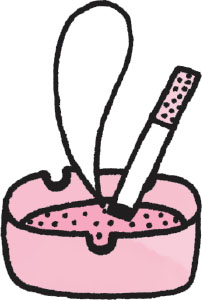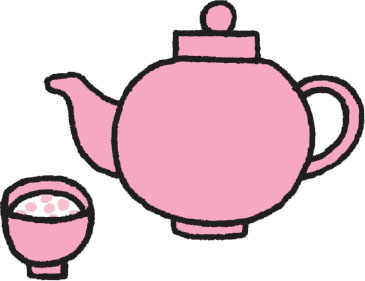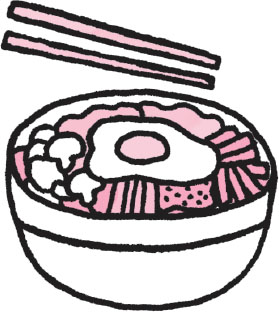10
Korean Beauty from the Inside Out:
How Your Lifestyle Affects Your Skin
In so many ways, when I moved to Seoul, I didn’t know what to expect at all. One thing I wasn’t worried about, though: stuffing my face. That was definitely going to happen, and I thoroughly looked forward to it.
Growing up in L.A., whether you wanted Korean BBQ, bibimbap, or copious amounts of kimchi, the local Korean restaurants did not disappoint. I’d always enjoyed Korean cuisine growing up, and seeking out the authentic versions of my favorite dishes was high on my Seoul bucket list.
But as much as I had a good handle on the grub and the chopsticks, there were still new culinary subtleties that I started to pick up on. For example, banchan was not just an amuse-bouche, much less decor for the table, my aunt and uncle explained. Rather, it could make or break the main dish. The banchan served was so important to the harmony of the dish as a whole, they said, that if a restaurant specializing in oxtail soup didn’t have good kimchi and kkakdugi (spicy radish) to pair with it, then that restaurant was surely not long for this world.

Since all banchan was not created equal, my palate soon developed so that I knew what was bomb banchan or just mediocre. Also, unlike spinach dip or an onion blossom, you could gorge on banchan and not feel a shred of guilt. You were just consuming lots of fresh and fermented veggies, an essential part of Korea’s health-focused culture.
#sokosecret: Many Korean people believe that fermented foods, such as kimchi, are rich in beneficial bacteria, powerful antioxidants, and enzymes that help with digestion and boost the immune system.
But the healthy effects of my new Korean lifestyle didn’t stop at side dishes. When I worked at Samsung, my colleagues would ask me to join them on a walk along a landscaped trail that meandered not far from our office building. Originally, I interpreted these requests to be romantic gestures, but then I noticed that almost everyone in the company was out in pairs or small groups, walking off their lunch.
From yoga to hikes (which were taken seriously in head-to-toe professional hiking gear, not like L.A. hikes where you stroll up a hill in flip-flops) to eating right, Koreans seemed to take their overall well-being as seriously as they took their skin care.
Obviously, while not everything about Korean culture was the healthiest (like late-night soju-drinking sessions or the heavy pork belly consumption), it was still clear to me that many people—whatever their age or gender—made a concerted effort to be knowledgeable about what was good for them and took steps to invest in and care for their bodies. This wasn’t a fad diet culture, as people seemed to understand and be okay with the fact that it might be twenty or thirty years before they reaped the benefits of what they were doing now. Instant gratification be damned—it will be worth it.
R-E-S-P-E-C-T Your Body
The basic truth: You can’t respect your skin but trash your body and still expect to look radiant. I’ve said before that skin care is more than skin deep, and I’ll say it again here. These are just a few tips for overall health that can have a major impact on your skin as well.
Drink a Lot of Water
Your body is about 60 percent water, so it makes sense that health authorities recommend drinking six to eight eight-ounce glasses a day (depending on if you exercise a lot). It keeps your immune system in tip-top shape, and it’s hard to find a healthy complexion on an unhealthy body.
Water is also connected to our blood circulation, which helps keep skin looking bright and fresh. But don’t overestimate the benefits of drinking water. I’ve heard this a million times: “I drink so much water. I don’t know why my skin is still so dehydrated all the time!” Here’s the deal: Water trickles down to your skin last. In other words, the water you drink is going to go to your kidneys, lungs, heart, and everything else first. You’re not going to suddenly achieve plump, hydrated skin by drinking a lot of water, because our bodies are just not that simple. You get the best results when you drink enough water and hydrate your skin topically with humectants that bind moisture to the skin.
Eat Well
Your skin will mirror what you eat. Eating a balanced diet is the optimal way to keep your body healthy, and it will also be reflected on the outside. So eat less of those things that end in -os (Cheetos, Doritos, Haribos) and more yogurts, greens, fish, fruits, whole grains, and lean protein.
But as with drinking water, what you eat won’t immediately improve your skin. Should you be eating an avocado or drinking green tea for the sake of your skin? Sure, the fatty acids and antioxidants are great sources of nutrition for your body as a whole. Like water, all the nutrients you get from food will be distributed to your vital organs first and then your skin. But in my book (and remember, this is my book!) this is just all the more reason to eat well, so that your mind and entire body (including your skin) are feeling nourished and in their optimal states.
Get Tons of Z’s
Go ahead, knock yourself out: Sleeping is one of the best things you can do for your skin. From running Soko Glam to writing this book to watching Running Man marathons (I can’t help it! Have you seen this show?), I’m no stranger to sleep deprivation. When I don’t get enough sleep, my body wastes no time in letting me know I’ve been very bad to it. I’m not as alert during the day and I get a lot of comments like, “Dude, you look tired.” But aside from just being groggy and not that much fun when you’re sleep deprived, the skin consequences range from puffy eyes to dark circles and even increased acne.
Why is getting seven to eight hours of deep sleep essential to your skin’s health? While you rest, your body repairs itself. During sleep, blood flows toward the skin (rather than your body’s core, as it does when you’re awake), and it brings oxygen to the skin. Also, sleep is when amino acid molecules build more collagen and fluid and toxins are drained.
Now you’re probably thinking about puffy eyes, which most of us have had to battle after pulling an all-nighter in college or a late-night job/school/boyfriend-related crying session. So what causes eyes to be puffy and, more important, how do we get rid of them?
While some of it can be hereditary (thank your parents), a lot of us do notice puffiness under the eyes after a night of tossing and turning. When we don’t get enough sleep, or enough good sleep, excess fluid near the skin isn’t transported to the bladder to be excreted; it sticks around in your face. There’s less fat in the area right under your eyes, so water retention is more apparent, and dark circles are specifically the result of lack of blood flow to the skin.
Sleep deprivation also weakens the skin barrier function (the immune system that blocks out bad bacteria and other foreign substances), which can lead to skin disorders like eczema and accelerate signs of aging.
Reduce Stress
Aw, stress. A lot of us have been here: You have a weird ailment, your doctor takes your temperature, pokes and prods you, and then says definitively, “It’s stress. You need to reduce your stress.” And then you’re just sitting there thinking, that can’t be right.
But your doctor is right; stress is something that we all have to learn to manage. It can make a significant impact on your overall health, and in your skin it shows in things like breakouts and premature aging.
How stress affects your body breaks down like this: Stress (including trauma, pain, illness, or just an everyday situation) causes your body to release hormones such as adrenaline and cortisol, which are supposed to increase your energy and help you deal with whatever stressful situation is at hand. However, high levels of these hormones for a prolonged period of time weakens the epidermal barrier, which aggravates existing conditions or delays wound healing. When cortisol levels rise, sebaceous glands produce more oil. So this is why, when you’re already stressed about trying to look your best—right before a date with a cute boy, or when you find out it will rain on your outdoor wedding—a big fat honker of a pimple decides to land on your nose.
Want proof? Look no further than our presidential figures. I’m teased a lot by my friends (and my husband) about my crush on President Obama. But after seven years in office, President Obama looks like he’s aged twenty years—you can see gray hair, deep wrinkles, and skin that just looks less plump and more sallow. While I still think he’s the cutest out of all our presidents, it’s proof enough that stress can do a number on your skin. Obama might not get a chance to chill out anytime soon, but you should definitely do what you can.
The Surprising Upside of a Cultural Taboo
Being in a completely different country halfway across the world, you’re bound to run into different mindsets and ways of living—you know, culture shock. Like using a bidet to wash your bum. At first it’s gross if you’re a newbie, but a few warm and satisfying squirts later, you’re actually disgusted that you’ve lived your whole life without one.
In many ways, Korea is more conservative than the United States. Get addicted to a romantic Korean drama and you’re going to be waiting a loooonnnggg time before the leads even kiss. After a few episodes, you start getting excited when it seems like they might hold hands! Premarital sex and living with your boyfriend are also still major social taboos, even though it’s obviously done. With my Korean parents still in California, I figured it was safe for Dave and me to move in together in Seoul, then my dad called to announce he was coming to visit! Yay—but crap.
I went into panic mode. I leased a furnished apartment for a month, and Dave and I moved an entire carload of my stuff from the apartment that we shared to my new, pretend solo studio. Right before my dad was scheduled to arrive, he called me from LAX to let me know that he was checked in and that his flight was on time. “Oh, and Charlotte,” he said before we hung up, “your mom wants to make sure you didn’t rent a fake apartment so that we wouldn’t know you’re living with your boyfriend.”
“No, of course not,” I said, laughing. “Why would I do that?” With the month lease already signed, I had no choice but to just brazen it out and pretend that my parents didn’t know exactly what I was up to. And let me tell you, a carload of stuff doesn’t look like that much when it’s all spread out in an apartment. When my aunt came to visit my dad and me at the apartment, she took one look around and said, “Where’s all your stuff?” while my dad and I sat there, smiling and avoiding a bit of cross-continental confrontation.
While my parents were capable of surprising me, I was equally surprised by Korea as a whole. After I accepted the job at Samsung and gave my two weeks’ notice, my American boss warned me to be careful and to be prepared for my opinions to not matter just because I was female. I brushed away his comments until I received my employment contract from Samsung. The fine print said that if I ever had a kid, I would have to be back in the office in three days after giving birth!
Holy shit! I thought. They try to push you out as soon as you’re a mom! Maybe my boss was right, and I was transporting myself back to the 1950s, where I’d just serve coffee all day, no matter what my title. But I was twenty-two and felt light-years away from being affected by any pregnancy clause, so I signed.
Turns out the contract had a typo—there was a full three-month maternity leave with an option to extend if needed. Also, my opinions mattered a lot, and I was well rewarded for them. By my second year at Samsung, I was traveling on overseas business trips with Vice President Hong Sung Il and the CEO Park Ki Seok for exclusive meetings that I pitched and proposed. By twenty-four I received a special bonus from the company; by twenty-five I was making hiring decisions and managing million-dollar events; and by twenty-six I was leading the international public relations team. Shortly after I left Seoul in 2013, Korea elected its first female president.
My former boss was wrong in many ways, but there were a few lingering cultural taboos that women in Korea still had to face. One of them was smoking. Whereas no one would bat an eye if a guy were to pull out a pack, it was considered decidedly improper for a female to do so. I’d walk past cafés or drinking establishments and see huddles of Korean men drinking coffee and smoking, a large smoke cloud above them—and not a woman in sight. After a few years in Korea, even I became conditioned to do a double take if I saw a woman light up in public. Women still smoked, of course, but discreetly. In the bathroom of clubs, you’d fight your way to the mirror through groups of women chain-smoking safely out of public view.
I personally dig a sexy cigarette scene (thank you, Wong Kar Wai movies) and can see why smoking has such appeal. I’ve smoked a handful of times in my life—including a few to deliberately push the envelope with my colleagues while I was in Korea—but I never picked up the habit. And thank God.

Now after diving deep into skin care, I’m even more grateful that my rebellious dalliances never led to a full-on habit, as it’s occurred to me that this sexist smoking taboo has unintentionally helped Korean women avoid the pitfalls of smoking, which is one of the worst things you can do for your skin.
Here, let me create a visual for you. When you take that puff, smoke enters your body and your bloodstream and affects almost every organ in your body in the process. Smoke passes through your breathing tubes, or bronchi, which causes inflammation and coughing. You subject yourself to the potential for bronchial infections, lung cancer, and emphysema in your respiratory system, and gum disease and tooth decay in your mouth. Tobacco stains your teeth—mmm, yellow—and taints your breath. Nicotine raises your blood pressure and makes your blood clot, leading to cholesterol deposits on artery walls. Increased stomach acid secretions cause heartburn and ulcers, and carcinogens from the cigarette are excreted in your urine, which can cause bladder cancer and liver damage.
So there’s that—now, on to your skin. Smoking reduces the amount of oxygen in your blood, and since blood flows to your skin last, the reduced oxygen starves skin cells and causes them to die off. Cellular turnover is slow, as cells are now dying as opposed to regenerating, and this leads to premature aging. Free radicals from cigarette smoke also cause cell damage and the breakdown of proteins. With less blood flow to your skin, your skin is less nourished, so skin tones can appear sallow and dull. It can also impact texture and smoothness. Furthermore, wounds are slower to heal, and you’re at greater risk for skin cancer.
Drowning Your Sorrows Is Bad for Your Skin
Taboos usually come with a tinge of hypocrisy, and Korea is no different. As much as smoking is taboo for women, chugging the national spirit (soju) from the “green bottle” isn’t. The green bottle is a big part of Korean culture. Sold readily at any convenience store for less than two bucks, soju has put Korea on the map for being the nation that drinks the most hard liquor: an average of 13.7 shots a week—twice the amount of Russia! The biggest celebs in Korea—usually actresses—are frequently soju spokesmodels, with their faces even on the bottle, and the green bottle is a popular trope in movies and dramas. When rejected by a love, or facing similar hardships, an actor recounts his or her woes while dramatically downing shots either alone or with friends in a pocha, a tented outdoor bar established as a spot where people come to drink themselves into a drunken stupor. When they stumble home or into work the next morning, everyone politely turns the other cheek.
Alcohol is my vice of choice, and I made the most of my time in Seoul. I love soju and wine, and soju mixed with watermelon juice in particular is my weakness. But as fun as drinking (in moderation) can be, alcohol does a number on your body and causes blood vessels to expand and widen, allowing more blood to flow through your skin. While this might sound great, it’s what creates that flush you get from drinking, and dilated blood vessels can lead to broken capillaries and a permanently ruddy complexion. High alcohol consumption also dehydrates your skin, increasing the appearance of fine lines. If you’ve ever looked in the mirror with a hangover and thought, Oh man, one night of drinking aged me five years!—bingo.
So while cutting out alcohol may be too much to ask, here are a few ways to decrease the impact of your consumption. One preventative measure is to make sure you moisturize your skin prior to drinking. Another is to opt for beer or wine (as a better alternative to spirits), and remember to take sips of water in between to keep you hydrated. After a night of drinking, it will be beneficial if you treat your face to a chilled sheet mask or a sleeping mask with vitamins and humectants for antioxidants and a hydration boost.
Boricha: Drink Up!
Go into any Korean household and you’ll see boricha in the fridge next to a stack of banchan in clear glass containers. Boricha is a nutty-flavored, antioxidant-packed roasted barley tea that’s chilled in the summer months and served warm in the winter. I’m convinced that diet contributes to a better body and better skin. Granted, there might not be a scientific study out there that explicitly connects the dots, but nonstop veggies + caffeine-free antioxidant tea = better health? Makes sense to me.

To make boricha, you can purchase loose barley grains and boil them in a pot for a few minutes before letting the mixture cool and transferring it to a pitcher. You can also buy barley tea bags that you pop into a pitcher and let soak for twenty minutes before discarding the bag.
Tea, though some contain caffeine, is also good for your skin, specifically green tea. It’s packed with antioxidants and also has anticarcinogenic effects, whether you drink it or apply it topically to your skin. Green tea can help prevent collagen breakdown and keep UV rays from wreaking havoc on your skin, which has made it a hugely popular skin-care ingredient.
So when it comes to tea, drink it up and slather it on, and leave the soju on the shelf.
ORDER THIS: My Ten Favorite Korean Dishes
1. Kimchi. A spicy cabbage prepared with pepper, garlic, ginger, and scallions. It is a fermented banchan that’s present at almost every meal and is said to offer a host of health benefits because it’s packed with antioxidants and is a probiotic.

2. Bibimbap. A colorful and healthy dish with rice and an assortment of fresh veggies (thinly sliced carrots, roots, and spinach, to name a few) topped with a runny or fried egg. Mix the ingredients, and add a dollop of sesame oil and spicy red paste to taste. If you’re on a Korean Air flight and bibimbap is one of the offerings, you can’t go wrong.
3. Haemul Pajeon. This pancake-like dish is cut into slices and dipped in soy sauce. It’s made with a batter of egg and flour mixed with a variety of veggies like green onions and kimchi and seafood like clams, squid, and oysters. It’s often enjoyed with makgeolli, a sweet rice wine.
4. Mul Naengmyun. While the words “cold noodles” might not get your blood pumping, this is a dish not to be ignored. Imagine buckwheat noodles in a cold beef broth topped with slices of cucumber, Korean pear, and a boiled egg, then seasoned with vinegar and gyeoja (a spicy mustard). It’s typically served in the summer, often after eating generous portions of Korean BBQ.
5. Samgyetang. Traditionally enjoyed on the hottest day of the year—to “fight heat with heat”—samgyetang is a stewed whole young chicken stuffed with ginseng, garlic, rice, and scallions and served piping hot. It’s believed that eating this dish three times a year brings optimal health benefits.
6. Gamjatang. This stew usually contains perilla leaves, which give it a lot of its delicious, rich flavor, and has a base of potatoes and pork spine. This dish is almost more delicious as leftovers: add rice and veggies to the soup reduction to make a scrumptious fried rice.
7. Tteokguk. Tteokguk is a beef broth soup garnished with slices of fried egg, pressed beef, and seaweed. It is traditionally eaten to celebrate the New Year and served with long oval strips of rice cake, which symbolize a long and healthy life.
8. Samgyupsal. What we’ve all been waiting for: Korean BBQ—Long strips of pork wrapped in lettuce leaves and coupled with grilled garlic slices, kimchi, soybean paste, and other banchan. The best Korean BBQ is grilled over hot coals, not gas, and is frequently paired with soju.
9. Tteokbokki. A dish that manages to be both sweet and spicy. Tteokbokki is sliced rice cakes smothered in red pepper paste and green onions. It’s a fairly inexpensive dish that is best when eaten at street carts and paired with a cup of fishcake soup (called oden).
10. Patbingsoo. Dessert time! Made with ice shavings and traditionally topped with condensed milk, sweet red beans (pat), and rice cake (tteok), patbingsoo is crunchy and sweet. You can find many variations with fruit and ice cream served at cafés and restaurants.
